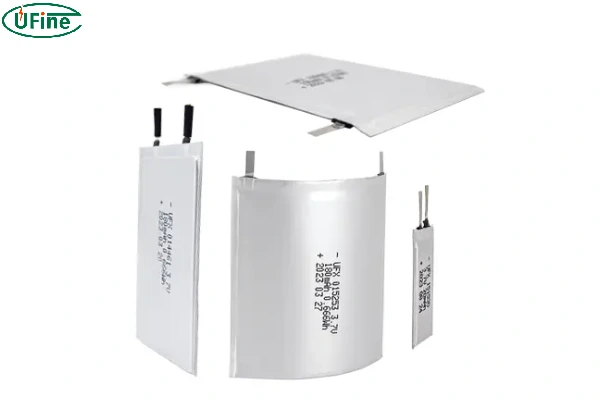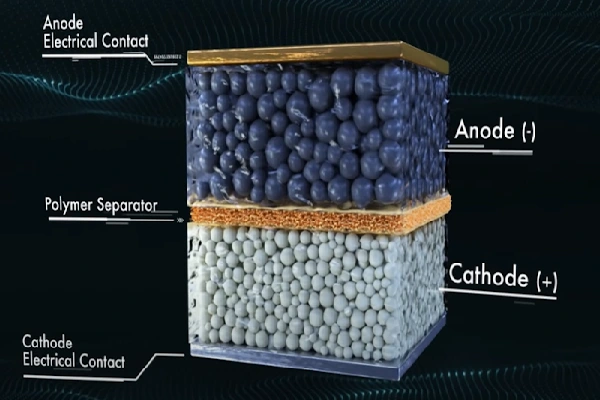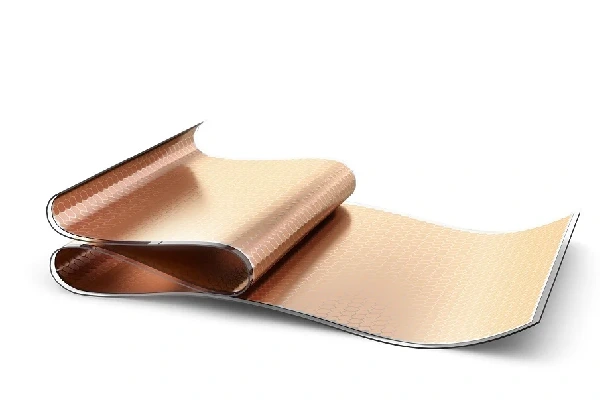A study claims that the global thin film lithium-ion battery market is expected to grow to US$ 904 million by the end of 2030. So, Keeping its significance in mind, let’s deal with the features and workings of the thinnest lithium-ion battery. We will also discuss the pros and cons of a thin film lithium-ion battery.
Part 1. What’s a thin film lithium ion battery?
The thinnest lithium-ion battery is a solid-state battery. Solid-state batteries contain solid electrolytes instead of liquid electrolytes. So, both the thin films and solid electrolytes make a thin lithium battery an efficient energy source. This battery has a higher voltage output. It is lightweight and is used in a variety of medical products.
Part 2. Thin film lithium-ion battery components
Usually, this battery consists of four components. These components may include cathode, anode, electrolyte, and separator.
1. Cathode
The cathode material is similar to that of other lithium batteries. The cathode has a composition of metal oxides. These may include Lithium manganese oxide (LiMn2O4), lithium iron phosphate (LiFePO4), and lithium cobalt oxide (LiCoO2). These materials have high specific energy. Moreover, they are stable. So, they are used as a cathode material in a thin lithium battery.
2. Anode
The anode plays an important role in the battery’s performance. The anode stores and releases lithium ions while the battery is working. So, the anode mostly comprises lithium metal. It also contains inorganic compounds. These inorganic compounds are silicon–tin oxynitrides, tin nitride Sn3N4, and zinc nitride Zn3N2. Additionally, metal films such as Cu can be used as anode after lithium plating.
3. Electrolyte
The electrolyte helps in the movement of lithium ions. This usually happens between the positive and negative plates. So, this feature differs from that of a thin lithium-ion battery to that of normal lithium batteries. The most commonly used electrolyte material is LiPON, lithium phosphorus oxynitride, and LiBON, lithium boron oxynitride. Solid electrolytes are quite popular because they reduce leakage. Moreover, they offer proper safety.
4. Separator
A separator is also an essential component in lithium-ion batteries. It allows the isolation of the anode and cathode. So, it avoids physical contact. But, it must not block the flow of lithium ions. As we all know, a solid electrolyte is present in a thin lithium-ion battery. So, there is no need for a specific separator. The electrolyte itself functions as a separator.
Part 3. How thin film lithium ion battery work
Have you ever think how thin-film lithium-ion batteries work? So, let’s discuss it here. A thin film lithium-ion battery works due to an electrochemical reaction. Here, lithium ions move from the cathode. Then, allow it to enter and flow through the electrolyte. After that, they move towards the anode. These ions are then deposited at the anode.
This process is known as charging.
During discharge, lithium ions return from the anode to the cathode. In this way, they produce current. The current is used to power electrical devices. A thin film lithium-ion battery allows faster movement of ions.
Thin Film Lithium Ion Battery Discharging
So, the following reactions occur at the anode and cathode during the discharging process of thin film lithium-ion.
At Anode: During discharging, the anode loses lithium ions. So, oxidation occurs at the anode. The following reaction takes place:
LiC6 ⇌ C6 + Li+ + e-
At Cathode: During discharging, lithium ions are deposited at the cathode. As a result, reduction occurs at the cathode. So, here is the reaction that proceeds at the positive electrode;
Li+ + e- + LiCoO2 ⇌ LiCoO2
Overall Discharging Reaction:
So, overall, the net reaction that occurs during discharging in the thin li-ion battery is:
LiC6 + LiCoO2 ⇌ 6C + LiCoO2
Hence, the energy is released. The released energy is used to power electrical devices.
Thin Film Lithium Ion Battery Charging
During charging, it works in the following way:
At Anode: Lithium ions move back toward the anode. So, the reverse of the discharging reaction takes place here.
C6 + Li+ + e- ⇌ LiC6
At Cathode: During charging, these li-ions travel away from the cathode. After that, they then enter the electrolyte. Lithium ions then again move towards the anode.
LiCoO2 ⇌ Li+ + e- + LiCoO2
Overall reaction during Charging:
Thus, the overall reactions that take place during the charging and recharging process are
LiC6 + LiCoO2 ⇌ 6C + LiCoO2
Hence, the battery is charged again in this way.
Part 4. Thin film li-ion batteries pros and cons
Thin Li-ion Batteries Pros
| Features | Properties of Thin Film Lithium Ion Batteries |
|---|---|
| Energy Density | High |
| Power Density | Moderate |
| Efficiency | Typically above 90% |
| Cycle Life | Up to 1200 cycles |
| Charge/Discharge Rate | Fast |
| Temperature Range | -20°C to 60°C |
| Weight | Lightweight |
| Flexibility | Flexible due to solid polymer electrolytes |
| Safety | Reduced risk of leakage |
| Cost | Relatively expensive |
- Higher Output Voltage: It increases the performance of a device. Moreover, It has a higher output voltage.
- Light in mass: This battery is quite light in weight. That is why they have a wide scope of applications
- High-Specific Heat: It has high specific heat. So it can store more energy in a compact mass.
- Flexible to use: These batteries are relevantly flexible to use. They usually consist of solid polymer electrolytes. So they can easily mold and change into many shapes. This is not feasible in traditional lithium-ion batteries because of their standard electrolytes.
- Large Temperature Variations: It can work in a wide range of temperatures. Moreover, they can operate at a lower temperature of -20°C. So, the higher temperature limit at which it works is 60°C.
- Longer life span: A thin lithium-ion battery has a relatively longer life span. So, it can withstand 1200 charging and discharging cycles. After 1200 charging cycles, it discharges completely.
- Quick Charging and Discharging Cycles: A thin lithium-ion battery can charge and discharge quickly. This is opposite to normal lithium-ion batteries.
- Safety: Traditional lithium-ion batteries have liquid electrolytes. They are at a risk of leakage. But, thin film lithium-ion batteries provide safety. This is because their solid electrolyte has no leakage.
Thin Li-ion Batteries Cons
- Costly: The composition of thin lithium batteries varies from ordinary lithium-ion batteries. These have a complex manufacturing process. That is why they are quite expensive
- Less strength: Their structural packaging is quite sensitive. They may not bear harsh conditions and shocks. So, these are less durable than traditional lithium-ion batteries.
- Limited Energy Storage Capacity: It has a high energy density. However, this battery can store a small amount of energy due to thin films.
Part 5. Thin film lithium-ion battery applications
So, a thin lithium battery has various applications in different devices. Let’s discuss a few of them here,
- Medical Devices: It can be used in equipment implanted in the human body, i.e., pacemakers.
- Electronics: It has quite significant use in mobile and portable electronic devices. Moreover, they are also used to store renewable energy in wind turbines or solar cells.
- Smart Devices: These have diverse applications in smart cards and wireless sensors. So, we can use thin lithium-ion batteries for numerous gadgets.
Part 6. Conclusion
In conclusion, the thin film lithium-ion battery is well-known for its solid electrolytes. The thin coating on electrodes makes it a flexible energy source. It generally powers portable and mobile electronics. A thin film lithium-ion battery has some cons as well. First, It is costly. It has a complex manufacturing process. Despite that, it is used in many gadgets, such as medical devices. Regardless of its few limitations, it is a good option for adoption.
Related Tags:
More Articles

LiPo Battery Discharge Rate Guide & Calculation Tips
Understand LiPo battery discharge rates, C-ratings, and how to calculate max current. Essential guide for RC, drones, and electronics users.
High‑Capacity 3S LiPo Batteries: 5000 mAh vs. 10000 mAh
Compare 3S LiPo 5000mAh vs 10000mAh batteries by weight, power, and use. Find the best fit for your drone, RC car, or boat setup.
Top 5 Applications for Small 3S LiPo Batteries
Small 3S LiPo batteries power drones, RC gear, wearables, and robotics with high energy and low weight. Making them ideal for compact electronics projects.
Building and Charging Your Own 3S LiPo Pack: A Step‑by‑Step Guide
Learn how to build, balance, and charge a 3S LiPo battery pack safely at home with this complete DIY guide for hobbyists and beginners.
How to Choose the Right LiPo Battery Plug Type?
Discover the best LiPo battery plug types, how to choose them, and expert tips for safe usage, soldering, and maintenance.






